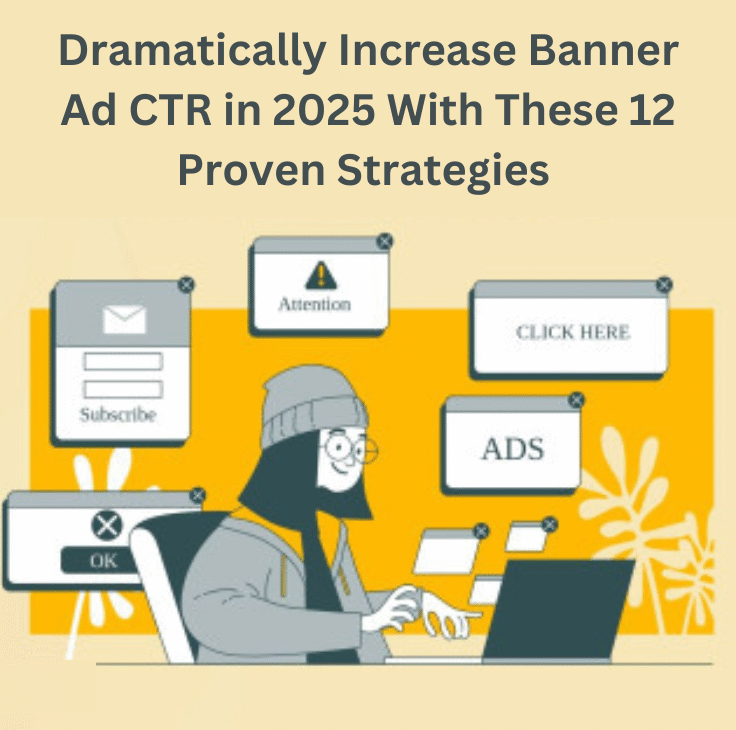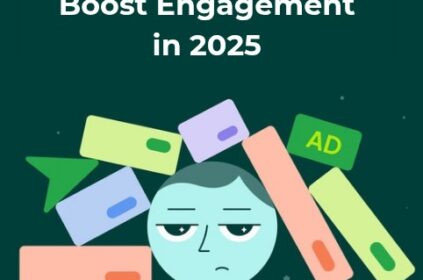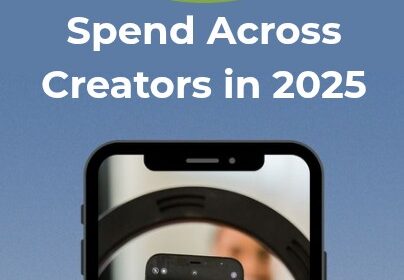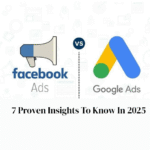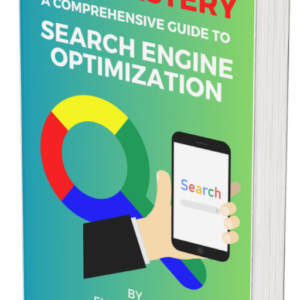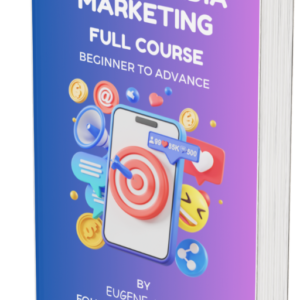At first glance, banners look doomed. Average Google Display units still hover around a 0.46 % click-through rate (CTR) across industries , while digital ad spend keeps rising at a double-digit clip.
Yet brands that focus obsessively on audience fit, lightning-fast load times, and message clarity continue to smash benchmarks.
Your goal this year is simple: increase banner ad CTR in 2025 so each paid impression pulls its weight.
This guide delivers a battle-tested blueprint and embeds hard data so you can track progress, secure budget, and silence “banner blindness” skeptics.
#1. Know the Numbers Before Chasing Them
Treat CTR like any other performance metric: diagnose, then prescribe. The formula—clicks ÷ impressions × 100—looks basic, yet it grounds every optimisation sprint.
At 6.66 % for search but just 0.46 % for display, the gulf is obvious . Start by logging your current figures for each campaign, creative size, and placement type.
When executives ask “what is a good CTR?” or “industry click-through rates,” you’ll have an answer that is context-rich, not guesswork.
Framing these conversations around the urgent need to increase banner ad CTR in 2025 turns vague ambition into a quantifiable goal—often a 25 % lift over 90 days.
Benchmarks also prevent panic. A B2B SaaS campaign with a 0.72 % CTR already doubles the broad average and may only need marginal tweaks, whereas a 0.12 % creative in consumer services is underperforming .
By isolating true laggards, you avoid over-engineering what’s already working and refocus resources where they matter most.
#2. Slice Your Audience Until the Message Feels One-To-One
Broad display targeting once made sense; CPMs were cheap and cookies worked everywhere. In 2025, privacy walls, shrinking third-party data, and AI bidding force a more surgical approach.
Use first-party signals—recent product views, email engagement scores, event attendance—to build micro-segments such as “returning visitors who abandoned a cart over $100.”
This hyper-specificity lets you increase banner ad CTR in 2025 by speaking directly to intent rather than merely demographics.
Apply the same principle across channels. Google Ads’ in-market segments, Facebook’s look-alikes seeded from high-LTV purchasers, and LinkedIn’s job-title filters all trim waste.
The payoff is higher relevancy, which quietly answers queries like “how to improve CTR in Google Ads” or “how to improve CTR Facebook Ads” without separate playbooks. A tight segment gets a tight creative—a synergy that multiplies clicks.
#3. Draft Content That Draws Attention
User attention spans are shorter than the time it takes a banner to fade in. That reality makes bold contrast, single dominant imagery, and verb-first headlines indispensable.
Real-world tests show switching a busy collage for a single product photo and adding a 20-pixel call-to-action (CTA) lifted clicks 38 %.
Visual hierarchy doubles as the answer to “How can I make my banner ads more effective?”—because clarity always beats cleverness.
A practical checklist to increase banner ad CTR in 2025 through design:
#1. Contrast & color: Use a two-color palette that pops against host content.
#2. Text length: Keep headline + subhead under 90 characters for crisp rendering.
#3. CTA size: Minimum 16 px font inside a 44 × 44 px hit zone.
#4. Directional cues: Arrows, diagonal lines, or eye gaze toward the button.
These guidelines cross borders seamlessly—Google Display Network, LinkedIn Sponsored Content, or even eBay’s Promoted Listings—so you handle “how to increase click-through rate eBay” by principle, not platform quirks.
#4. Write Relatable Copy
Every banner gets two jobs: surface a visceral problem and present a frictionless next step. That clarity raises curiosity, triggers emotion, and compels action.
To increase banner ad CTR in 2025, tighten each line until it could headline a landing page. Instead of “Industry-leading project management software,” try “Projects late? Cut chaos by Friday.” The pain—lateness—meets the promise—order. Emotion first, feature later.
This discipline travels well. YouTube’s overlay ads benefit from the same compression, answering “how to increase click-through rate on YouTube” without a separate rulebook.
Email banners inside newsletters can mirror it to “how to improve click-through rate email,” reinforcing message consistency across the funnel.
#5. Embrace AI-driven Personalisation
Meta’s Advantage+ and Google Performance Max assemble creative combinations in real time, testing endless permutations against micro-audiences.
Brands leaning in see engagement gains up to 80 %. Yet the best performers keep a human hand on the tiller: they lock one overarching headline to maintain brand positioning and allow AI to remix subheads, images, and CTAs.
Doing so ensures you can still intentionally increase banner ad CTR in 2025 while guarding against machine-generated off-brand phrasing.
Review asset-level reports weekly. Pause low-scorers, upload fresh angles, and let the algorithm redeploy. Over time, your campaign evolves in near-real-time—organic Darwinism for ad copy.
#6. Design Explicitly For In-App Environments
Mobile rules display: in-app placements are set to command 82.3 % of all mobile ad spend this year. They render differently and carry their own etiquette.
Embed CTAs in the thumb zone—bottom-center for portrait, bottom-right for landscape—and compress assets below 150 kB to protect load speed.
Reward ads (coins, article unlocks) turn attention into deliberate action, a tactic directly raising “in-app banner” performance without alienating users.
Following these principles lets you increase banner ad CTR in 2025 within gaming, utility, and news apps alike and negates future questions about “how would you improve click-through rates for an in-app banner.”
#7. Engineer For Speed And Viewability
A gorgeous, targeted banner that never fully loads scores zero clicks. Minimize HTTP calls, adopt asynchronous tags, and strip non-critical JavaScript.
Google reports that when load times drop from one second to five, bounce probability jumps 90 %. Faster ads surface longer, score higher viewability, and inherently increase banner ad CTR in 2025.
Parallel that effort with strategic placement: first in-feed slot on content-heavy pages or directly beneath primary nav bars.
Prime real estate multiplies visibility—quietly addressing “best practice click-through rate for banners” by placing quality creative where it’s seen early.
#8. Sync Banners With Cross-Channel Reinforcement
No display unit operates in isolation. Pairing banners with sequential email flows reconverts warm leads; mirroring message and visuals lifts overall campaign CTR by up to 26 %.
On YouTube, pre-roll paired with companion banners amplifies recall and addresses “what is a good click-through rate on YouTube” by building a multi-touch journey.
For e-commerce sellers, replicating banner creative in eBay Promotions Manager meets shoppers mid-hunt, satisfying the urge to click when trust is already high.
Each channel synergy nudges you closer to the mandate to increase banner ad CTR in 2025 while pushing blended ROAS higher.
#9. A/B Test Relentlessly
Split testing remains the reigning champion of optimisation. Alter exactly one variable—say, headline wording—from Version A to Version B, and run until 90 % confidence.
Early in a campaign, you might test imagery; mid-flight, CTA color; later, value proposition hierarchy. Every iteration should intentionally aim to increase banner ad CTR in 2025, not merely generate novelty.
Document results in a living playbook. Over quarters, patterns appear: your audience might love direct questions in headlines or a specific shade of green for CTAs.
These insights compound like interest, pushing future creative out of the gate at higher baselines.
#10. Drafts Multi-Frame Ad Narratives
The biggest jump you can make to increase banner ad CTR in 2025—once the fundamentals above are humming—is to stitch every display touch into a deliberate, multi-frame narrative.
Think of your ads less like isolated billboards and more like comic-book panels that unfold in a set order across a user’s week.
#1. Map the buyer’s micro-moments. Break a typical consideration cycle into three or four emotional beats—curiosity, research, comparison, decision. Each beat gets its own banner variation with copy and imagery tailored to that psychic state.
#2. Use time-boxed frequency caps. Serve Panel 1 no more than twice in 24 hours; Panel 2 only triggers after Panel 1 wins a click or a full view.
This prevents creative fatigue and keeps the story moving forward, a proven way to increase dwell time and organically increase banner ad CTR in 2025 as users anticipate the “next episode.”
#3. Anchor the sequence with dynamic content rules. Platforms like Google Ads’ IF functions or a DSP’s creative decision-tree can swap headlines on the fly—“Still comparing options?” on the second exposure, “Ready to choose?” on the fourth—without manual uploads.
#4. Measure narrative completion, not just clicks. Track how many users see the entire progression. Brands that maintain a 60 %+ completion rate often notice overall CTR climbing 30–40 % because viewers feel guided rather than bombarded.
By treating banners as serialized storytelling instead of disjointed reminders, you introduce novelty, build suspense, and hit the user’s evolving mindset with uncanny timing—all of which combine to decisively increase banner ad CTR in 2025 and beyond.
11. Partner with Contextual-Authority Publishers
Even the best-designed units struggle when they sit on irrelevant pages. Strike direct deals (or private-marketplace PMP buys) with niche publishers whose content aligns one-to-one with your offer—think cybersecurity blogs for a VPN brand or gluten-free recipe hubs for a celiac-friendly meal kit.
#1. Co-create ad slots. Ask the publisher to design bespoke placements that inherit the site’s typography or color palette. Native-feel frames lift perceived credibility and often double raw click volume.
#2. Leverage semantic signals. Platforms like GumGum and Seedtag scan article text in real time and bid only when fresh page copy matches your core keywords, keeping every impression hyper-relevant.
#3. Negotiate value-add testing. Because these partners own their real estate, they’re usually open to A/B’ing layout tweaks on your behalf—prime ground to quietly increase banner ad CTR without inflating media fees.
12. Close the Loop with Zero-Party Data Experiments
First-party data tells you what users did. Zero-party data—insights people hand over willingly—tells you what they actually want. Layering that intent back into display campaigns tightens relevance further.
#1. Capture micro-signals. Short onsite quizzes (“Pick your biggest ad-tech headache”) feed preferences straight into your CDP.
#2. Spin up dynamic creative. Pipe those declared pains directly into headline variants served via Google Ads’ data-feed insertion or a DSP decision tree.
#3. Run “declare-then-deliver” tests. Show half your quiz takers a banner reflecting their answer, and half a generic control. Monitor lifts in both CTR and downstream conversion to prove the ROI of zero-party personalization.
Teams that treat banners as a living extension of conversational data regularly outpace static competitors—locking in another practical way to increase banner ad CTR while sharpening lifetime value.
Final Thoughts
CTR isn’t a vanity metric; it’s an early health indicator for creative resonance, audience targeting, and funnel cohesion. Your mandate is to continually increase banner ad CTR in 2025, not by chance but through iterative science.
Audit baselines, sharpen segments, design for immediate comprehension, harness AI judiciously, code for speed, and test like a lab technician on caffeine. When those habits take root, click volume rises almost automatically, and display stops looking like a budget drain.
Commit to that discipline, and the next time a stakeholder asks, “How do we boost our banners?” you’ll point to a live dashboard trending skyward—proof that smart strategy, not more spend, made the pixels finally pay off.At first glance, banners look doomed. Average Google Display units still hover around a 0.46 % click-through rate (CTR) across industries , while digital ad spend keeps rising at a double-digit clip.
Yet brands that focus obsessively on audience fit, lightning-fast load times, and message clarity continue to smash benchmarks.
Your goal this year is simple: increase banner ad CTR in 2025 so each paid impression pulls its weight.
This guide delivers a battle-tested blueprint and embeds hard data so you can track progress, secure budget, and silence “banner blindness” skeptics.
#1. Know the Numbers Before Chasing Them
Treat CTR like any other performance metric: diagnose, then prescribe. The formula—clicks ÷ impressions × 100—looks basic, yet it grounds every optimisation sprint.
At 6.66 % for search but just 0.46 % for display, the gulf is obvious . Start by logging your current figures for each campaign, creative size, and placement type.
When executives ask “what is a good CTR?” or “industry click-through rates,” you’ll have an answer that is context-rich, not guesswork.
Framing these conversations around the urgent need to increase banner ad CTR in 2025 turns vague ambition into a quantifiable goal—often a 25 % lift over 90 days.
Benchmarks also prevent panic. A B2B SaaS campaign with a 0.72 % CTR already doubles the broad average and may only need marginal tweaks, whereas a 0.12 % creative in consumer services is underperforming .
By isolating true laggards, you avoid over-engineering what’s already working and refocus resources where they matter most.
#2. Slice Your Audience Until the Message Feels One-To-One
Broad display targeting once made sense; CPMs were cheap and cookies worked everywhere. In 2025, privacy walls, shrinking third-party data, and AI bidding force a more surgical approach.
Use first-party signals—recent product views, email engagement scores, event attendance—to build micro-segments such as “returning visitors who abandoned a cart over $100.”
This hyper-specificity lets you increase banner ad CTR in 2025 by speaking directly to intent rather than merely demographics.
Apply the same principle across channels. Google Ads’ in-market segments, Facebook’s look-alikes seeded from high-LTV purchasers, and LinkedIn’s job-title filters all trim waste.
The payoff is higher relevancy, which quietly answers queries like “how to improve CTR in Google Ads” or “how to improve CTR Facebook Ads” without separate playbooks. A tight segment gets a tight creative—a synergy that multiplies clicks.
#3. Draft Content That Draws Attention
User attention spans are shorter than the time it takes a banner to fade in. That reality makes bold contrast, single dominant imagery, and verb-first headlines indispensable.
Real-world tests show switching a busy collage for a single product photo and adding a 20-pixel call-to-action (CTA) lifted clicks 38 %.
Visual hierarchy doubles as the answer to “How can I make my banner ads more effective?”—because clarity always beats cleverness.
A practical checklist to increase banner ad CTR in 2025 through design:
#1. Contrast & color: Use a two-color palette that pops against host content.
#2. Text length: Keep headline + subhead under 90 characters for crisp rendering.
#3. CTA size: Minimum 16 px font inside a 44 × 44 px hit zone.
#4. Directional cues: Arrows, diagonal lines, or eye gaze toward the button.
These guidelines cross borders seamlessly—Google Display Network, LinkedIn Sponsored Content, or even eBay’s Promoted Listings—so you handle “how to increase click-through rate eBay” by principle, not platform quirks.
#4. Write Relatable Copy
Every banner gets two jobs: surface a visceral problem and present a frictionless next step. That clarity raises curiosity, triggers emotion, and compels action.
To increase banner ad CTR in 2025, tighten each line until it could headline a landing page. Instead of “Industry-leading project management software,” try “Projects late? Cut chaos by Friday.” The pain—lateness—meets the promise—order. Emotion first, feature later.
This discipline travels well. YouTube’s overlay ads benefit from the same compression, answering “how to increase click-through rate on YouTube” without a separate rulebook.
Email banners inside newsletters can mirror it to “how to improve click-through rate email,” reinforcing message consistency across the funnel.
#5. Embrace AI-driven Personalisation
Meta’s Advantage+ and Google Performance Max assemble creative combinations in real time, testing endless permutations against micro-audiences.
Brands leaning in see engagement gains up to 80 %. Yet the best performers keep a human hand on the tiller: they lock one overarching headline to maintain brand positioning and allow AI to remix subheads, images, and CTAs.
Doing so ensures you can still intentionally increase banner ad CTR in 2025 while guarding against machine-generated off-brand phrasing.
Review asset-level reports weekly. Pause low-scorers, upload fresh angles, and let the algorithm redeploy. Over time, your campaign evolves in near-real-time—organic Darwinism for ad copy.
#6. Design Explicitly For In-App Environments
Mobile rules display: in-app placements are set to command 82.3 % of all mobile ad spend this year. They render differently and carry their own etiquette.
Embed CTAs in the thumb zone—bottom-center for portrait, bottom-right for landscape—and compress assets below 150 kB to protect load speed.
Reward ads (coins, article unlocks) turn attention into deliberate action, a tactic directly raising “in-app banner” performance without alienating users.
Following these principles lets you increase banner ad CTR in 2025 within gaming, utility, and news apps alike and negates future questions about “how would you improve click-through rates for an in-app banner.”
#7. Engineer For Speed And Viewability
A gorgeous, targeted banner that never fully loads scores zero clicks. Minimize HTTP calls, adopt asynchronous tags, and strip non-critical JavaScript.
Google reports that when load times drop from one second to five, bounce probability jumps 90 %. Faster ads surface longer, score higher viewability, and inherently increase banner ad CTR in 2025.
Parallel that effort with strategic placement: first in-feed slot on content-heavy pages or directly beneath primary nav bars.
Prime real estate multiplies visibility—quietly addressing “best practice click-through rate for banners” by placing quality creative where it’s seen early.
#8. Sync Banners With Cross-Channel Reinforcement
No display unit operates in isolation. Pairing banners with sequential email flows reconverts warm leads; mirroring message and visuals lifts overall campaign CTR by up to 26 %.
On YouTube, pre-roll paired with companion banners amplifies recall and addresses “what is a good click-through rate on YouTube” by building a multi-touch journey.
For e-commerce sellers, replicating banner creative in eBay Promotions Manager meets shoppers mid-hunt, satisfying the urge to click when trust is already high.
Each channel synergy nudges you closer to the mandate to increase banner ad CTR in 2025 while pushing blended ROAS higher.
#9. A/B Test Relentlessly
Split testing remains the reigning champion of optimisation. Alter exactly one variable—say, headline wording—from Version A to Version B, and run until 90 % confidence.
Early in a campaign, you might test imagery; mid-flight, CTA color; later, value proposition hierarchy. Every iteration should intentionally aim to increase banner ad CTR in 2025, not merely generate novelty.
Document results in a living playbook. Over quarters, patterns appear: your audience might love direct questions in headlines or a specific shade of green for CTAs.
These insights compound like interest, pushing future creative out of the gate at higher baselines.
#10. Drafts Multi-Frame Ad Narratives
The biggest jump you can make to increase banner ad CTR in 2025—once the fundamentals above are humming—is to stitch every display touch into a deliberate, multi-frame narrative.
Think of your ads less like isolated billboards and more like comic-book panels that unfold in a set order across a user’s week.
#1. Map the buyer’s micro-moments. Break a typical consideration cycle into three or four emotional beats—curiosity, research, comparison, decision. Each beat gets its own banner variation with copy and imagery tailored to that psychic state.
#2. Use time-boxed frequency caps. Serve Panel 1 no more than twice in 24 hours; Panel 2 only triggers after Panel 1 wins a click or a full view.
This prevents creative fatigue and keeps the story moving forward, a proven way to increase dwell time and organically increase banner ad CTR in 2025 as users anticipate the “next episode.”
#3. Anchor the sequence with dynamic content rules. Platforms like Google Ads’ IF functions or a DSP’s creative decision-tree can swap headlines on the fly—“Still comparing options?” on the second exposure, “Ready to choose?” on the fourth—without manual uploads.
#4. Measure narrative completion, not just clicks. Track how many users see the entire progression. Brands that maintain a 60 %+ completion rate often notice overall CTR climbing 30–40 % because viewers feel guided rather than bombarded.
By treating banners as serialized storytelling instead of disjointed reminders, you introduce novelty, build suspense, and hit the user’s evolving mindset with uncanny timing—all of which combine to decisively increase banner ad CTR in 2025 and beyond.
11. Partner with Contextual-Authority Publishers
Even the best-designed units struggle when they sit on irrelevant pages. Strike direct deals (or private-marketplace PMP buys) with niche publishers whose content aligns one-to-one with your offer—think cybersecurity blogs for a VPN brand or gluten-free recipe hubs for a celiac-friendly meal kit.
#1. Co-create ad slots. Ask the publisher to design bespoke placements that inherit the site’s typography or color palette. Native-feel frames lift perceived credibility and often double raw click volume.
#2. Leverage semantic signals. Platforms like GumGum and Seedtag scan article text in real time and bid only when fresh page copy matches your core keywords, keeping every impression hyper-relevant.
#3. Negotiate value-add testing. Because these partners own their real estate, they’re usually open to A/B’ing layout tweaks on your behalf—prime ground to quietly increase banner ad CTR without inflating media fees.
12. Close the Loop with Zero-Party Data Experiments
First-party data tells you what users did. Zero-party data—insights people hand over willingly—tells you what they actually want. Layering that intent back into display campaigns tightens relevance further.
#1. Capture micro-signals. Short onsite quizzes (“Pick your biggest ad-tech headache”) feed preferences straight into your CDP.
#2. Spin up dynamic creative. Pipe those declared pains directly into headline variants served via Google Ads’ data-feed insertion or a DSP decision tree.
#3. Run “declare-then-deliver” tests. Show half your quiz takers a banner reflecting their answer, and half a generic control. Monitor lifts in both CTR and downstream conversion to prove the ROI of zero-party personalization.
Teams that treat banners as a living extension of conversational data regularly outpace static competitors—locking in another practical way to increase banner ad CTR while sharpening lifetime value.
Final Thoughts
CTR isn’t a vanity metric; it’s an early health indicator for creative resonance, audience targeting, and funnel cohesion. Your mandate is to continually increase banner ad CTR in 2025, not by chance but through iterative science.
Audit baselines, sharpen segments, design for immediate comprehension, harness AI judiciously, code for speed, and test like a lab technician on caffeine. When those habits take root, click volume rises almost automatically, and display stops looking like a budget drain.
Commit to that discipline, and the next time a stakeholder asks, “How do we boost our banners?” you’ll point to a live dashboard trending skyward—proof that smart strategy, not more spend, made the pixels finally pay off.

